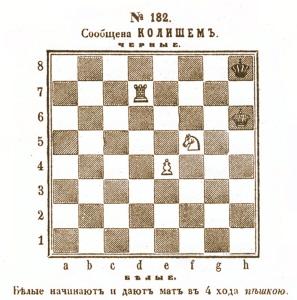Chess
Notes
|
| First column | << previous | Archives [52] | next >> | Current column |
5818. Fischer v whom? (C.N. 5813)
A number of readers correctly identified Fischer’s opponent as Jonathan Penrose, at the Leipzig Olympiad, 1960.
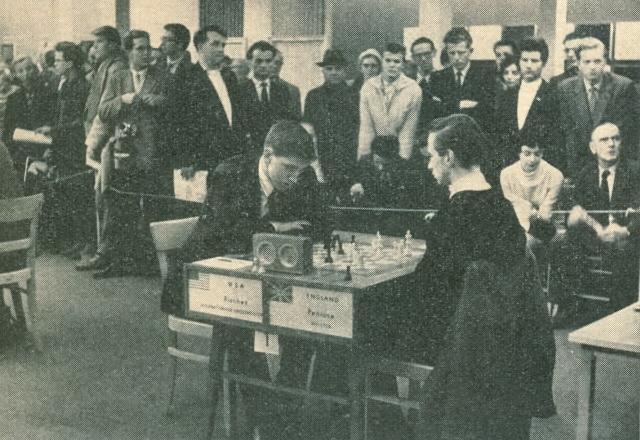
The photograph appeared on page 11 of Schach-Echo, 8 January 1961.
5819. Time
John Hilbert (Amherst, NY, USA) notes that it is now possible to search the full run of Time (1923-2008). Our link will take readers to the issue of 7 December 1925, which featured Capablanca on the front cover.
5820. Capablanca v Thomas (C.N.s 4727 & 4730)

Regarding this position from Capablanca v Thomas, Carlsbad, 1929, Yasser Seirawan (Amsterdam) remarked in C.N. 4730:
‘A quick impression is that Black should win by direct means after 47 Rd7: 47...b2 48 Rd1 Kb4 49 Rb1 Kb3! 50 f4 Rc1! 51 Rxb2+ Kxb2 52 Kh4 (With the rook now on the first rank the advance 52 f5 is a mistake as 52...Rf1 53 e4 Kc3 makes the task easy.) 52...Rc6! (Covering the h6-pawn, cutting off the white king and preparing to bring the black king into play.) 53 g4 Kc3 54 Kh5 Kd3 55 g5 hxg5 56 fxg5 Ke4, and Black is in time to stop the pawns for a win.
This is by no means an exhaustive analysis, but just a check of the direct line. It is possible that 50 f4 is wrong, but I based my analysis on that move as it seemed to be the main line of others.’
Dennis Monokroussos (South Bend, IN, USA) has now written to us:
‘Regarding the interesting and surprisingly complex Capablanca-Thomas endgame, Yasser Seirawan addresses 52 Kh4 and 52 f5, correctly noting that both moves lose. White has a third possibility, however: 52 Kg4. This prepares to shoulder off the Black king and should be good enough for a draw. For example: 52...Rc6 53 f5 Kc3 54 Kf4 Kd3 55 Ke5 Kxe3 56 f6, with a drawn position. One possibility is 56...Kf2 57 f7 Rc8 58 g4 Kg3 59 Kf6 Kxh3 60 g5 hxg5 61 Kxg5, followed by Kg6-Kg7-f8(Q).’
Yasser Seirawan comments:
‘The idea proposed by Mr Monokroussos is a very good one. His plan of shouldering away Black’s king in the line he gave after 52...Rc6 was certainly missed by me. I likely entertained 52 Kh4 as the main move in order to prepare g2-g4 in one go, so to speak. The move 52 Kg4 invites Black to play 52...Rg1, putting the rook behind White’s g-pawn with the gain of a tempo, which is why I rejected the move. However, White can draw by jettisoning the g-pawn with 52...Rg1 53 Kh5 Rxg2 54 Kxh6 Kc3 55 f5 Rf2 56 Kg6 Kc4 57 h4 Kd5 58 h5, when Black has various tries, but White is fast enough. For example: 58...Kd6 59 h6 Ke7 60 h7 Rg2+ 61 Kh5 Kf7 62 h8(N)+ Kf6 63 Ng6, and the knight escapes thanks to the help of White’s pawns.’
5821. Early chess literature
Josep Alió (Tarragona, Spain) writes:
‘From September 1897 to January 1898 the American Chess Magazine published a series of interesting articles under the title “Early Chess Literature” (pages 201-203, 262-264, 325-329, 400-407 and 457-462). The articles were anonymous except that at the conclusion of the second one (page 264 of the October 1897 issue) authorship was ascribed to “L.D.B., Jr.” Who was the author?’
He was L.D. Broughton, Jr., who edited the Magazine for part of its run (see, for instance, page 330 of the November 1897 issue). His address was given as 426 Greene Avenue, Brooklyn, NY on page 451 of the January 1898 number. In the following decade Broughton’s name appeared on the mast-head of Lasker’s Chess Magazine, which identified him as an Associate Editor.
As so often in such cases, Jeremy Gaige’s Chess Personalia is invaluable in the quest for biographical details. The entry on Luke D. Broughton takes us to obituaries of him on page 137 of the November-December 1947 American Chess Bulletin and on page 78 of the New York Times, 7 December 1947.
5822. ‘All rook endgames are drawn’ (C.N.s 5498, 5585 & 5726)
From page 105 of Das Schachspiel by Siegbert Tarrasch (Berlin, 1931):
‘Im Turmendspiel hat die schwächere Partei meist bis zum Schluß Remischancen.’
The English translation on page 81 of The Game of Chess (London, 1935) read:
‘In rook endings the weaker side generally has some chances of a draw right up to the very end.’
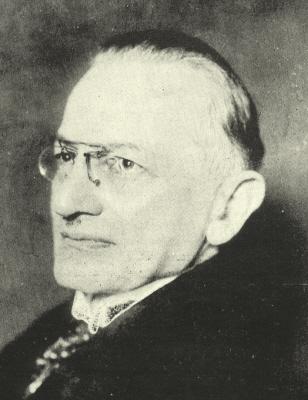
Siegbert Tarrasch
5823. Tarrasch’s most famous quote
As mentioned in The Most Famous Chess Quotations, Tarrasch’s observation ‘Chess, like love, like music, has the power to make men happy’ appeared on page xi of The Game of Chess.
Owners of the 1994 algebraic edition of Tarrasch’s book, edited by Lou Hays and David Sewell, are invited to look for the passage.
5824. Fischer remarks
C.N. 5534 asked, without result so far, about the origins of a remark commonly ascribed to Fischer: ‘All I want to do, ever, is play chess.’
Now, Chris Boys (Tamil Nadu, India) refers to another alleged comment of Fischer’s: ‘I don’t believe in psychology. I believe in good moves.’ A number of Internet outlets indicate that Fischer made the remark to the Washington Post in 1972. What evidence can be found?
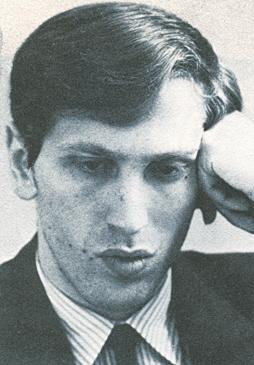
Bobby Fischer
5825. Quotes
The weakest field in all chess literature is surely quotes. Innumerable carefree outlets cite alleged remarks, without any attempt to supply even a vague source, let alone proof of authenticity. Whole books have been written along such lines, and no good volume of chess quotes has yet appeared in any language. Unimpressive websites may have a source-free ‘quote of the day’ or, even, long lists of purported remarks by luminaries, and others, all without substantiation. Writers fall back on know-nothing/tell-nothing introductions such as ‘Botvinnik is quoted as saying ...’, ‘As Tartakower once wrote ...’, ‘I read somewhere that Steinitz claimed ...’, ‘Wasn’t it Alekhine who remarked ...?’, ‘I’ve heard that Tarrasch often observed ...’, ‘Sources I’ve seen say that Lasker stated ...’ and ‘It is widely reported that Fischer said ...’ In short, the whole domain, reflecting an excess of name-dropping and a deficit of rigour, is a shambles.
5826. Philidor and pawns
Our feature article The Most Famous Chess Quotations includes the following:
‘... les Pions. Ils ſont l’ame des Echècs.’ (Modern spelling: ‘... les Pions. Ils sont l’âme des Echecs ...’) L’Analyze des Echecs by F.-A.D. Philidor (London, 1749), page xix.
‘... the Pawns: They are the very Life of this Game.’ Chess Analysed [Cheſs Analyſed] by F.-A.D. Philidor (London, 1750), pages ix-x.
Bill Brock (Chicago, IL, USA) notes that the customary English version is, of course, ‘Pawns are the soul of chess’, and we wonder when that exact wording was first seen in print. And has it ever appeared in any English edition of Philidor’s book?
5827. Queen’s knight’s pawn
A number of quotes and anecdotes concern the dangers of capturing the queen’s knight’s pawn, a matter raised by Alan Brooks (Ilford, England). Readers’ assistance in building up a collection of such citations and stories will be appreciated.
5828. Réti and Americanism
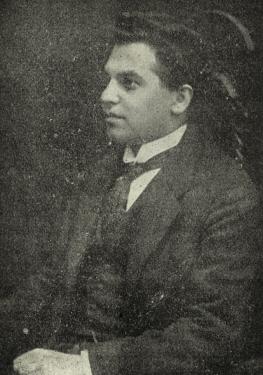
Richard Réti
Peter Morris (Kallista, Victoria, Australia) quotes the final passage of Modern Ideas in Chess by Richard Réti (London, 1923):
‘But one thing is certain. If Americanism is victorious in chess, it will also be so in life. For in the idea of chess and the development of the chess mind we have a picture of the intellectual struggle of mankind.’
This text was on page 181 of the English edition but had not appeared in Die neuen Ideen im Schachspiel (Vienna, 1922). Where can the original be found?
5829. Napier on problems
Michael McDowell (Westcliff-on-sea, England) asks for the origin of a remark attributed to W.E. Napier on page 260 of 777 “Chess Miniatures in Three” by E. Wallis (Scarborough, 1908):
‘A good problem – to the connoisseur is a canvas, a poem, a symphony, and quite as permanent.’
5830. Fischer quote (C.N. 5824)
C.N. 5824 gave the Fischer quote, ‘I don’t believe in psychology. I believe in good moves’, which is seen regularly, without a specific source. Mark McCullagh (Belfast, Northern Ireland) notes that it appeared in the New York Times of 4 July 1972, and below we give the details.
The article, ‘Fischer Leaves for Iceland After Briton Adds to Prize’ by Peter Kihss, was published on pages 1 and 14. A number of remarks by Fischer were quoted, and the relevant passage, on page 14, is:
‘Fischer’s own comments came during an interview at the home of Fred M. Saidy, musical-comedy author, at 2 Cedar Lane, Douglaston. The press had been invited by Mr Saidy’s son Anthony, a physician and a chess master who often competes in international play.
... Asked whether the backing and filling, the demands he was reported to have made and the objections he was said to have lodged were an effort to make a psychological impact on his opponent, Fisher [sic] replied:
“I don’t believe in psychology. I believe in good moves.”’
5831. Canal’s date and place of birth
Luca D’Ambrosio (Bolzano, Italy) informs us that on 2 November 2008 he took two photographs of the grave of Esteban Canal and his wife Anna Klupacs in Cocquio Trevisago, Italy:

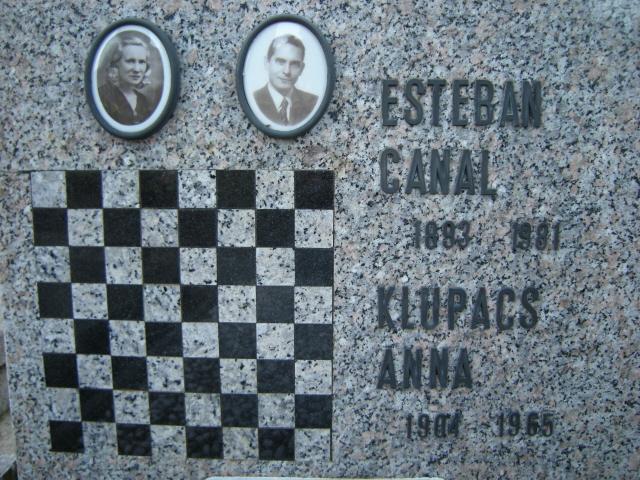
Canal’s year of birth is given as 1893, whereas standard reference books (e.g. Chess Personalia and the Dizionario enciclopedico degli scacchi) state that he was born on 19 April 1896, in Chiclayo, Peru.
Our correspondent mentions that doubts as to the facts were expressed by Alvise Zichichi on page 2 of his book Esteban Canal (Brescia, 1991). According to Zichichi, Canal sometimes said in private that he was born before 1896 and in Spain, not Peru. The book also noted Giancarlo dal Verme’s statement in L’Italia Scacchistica, April 1981, pages 106-107, that Canal was born in Santander, Spain of a Spanish mother and a Peruvian father.
5832. Walbrodt
C.N. 3146 (see page 187 of Chess Facts and Fables) quoted an observation by Pillsbury in Saturday Review of 31 August 1895 (regarding Hastings, 1895) that Carl Walbrodt was ‘a very small man also, the smallest of all the competitors’. We then commented:
‘Pillsbury’s remark is confirmed by other descriptions and photographs, with one exception: in the Dresden, 1892 photograph on page 56 of A Picture History of Chess by F. Wilson the player identified as Walbrodt appears taller even than Blackburne’.
The photograph also appeared on the dust-jacket of the Edition Olms compendium of three tournament books (Breslau, 1889, Dresden, 1892 and Kiel, 1893):
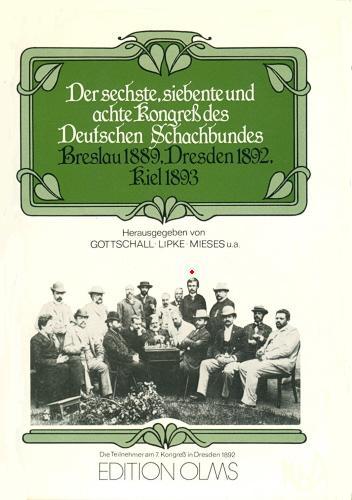
A detail of the player in question (from A Picture History of Chess) is given below:
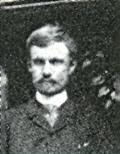
Neil Kaplan (Edenvale, South Africa) now suggests that this figure, identified as Walbrodt by Fred Wilson, was Georg Marco.
For purposes of comparison, we reproduce two parts of the rare group photograph of Hastings, 1895 referred to in C.N. 4663:
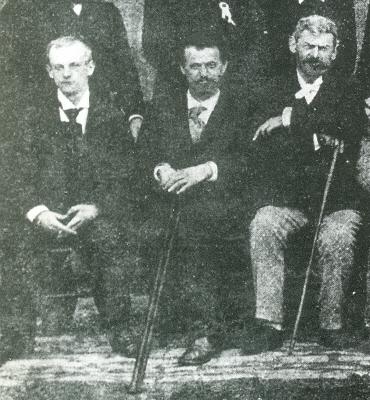
C.A. Walbrodt, B.
Vergani, A. Albin
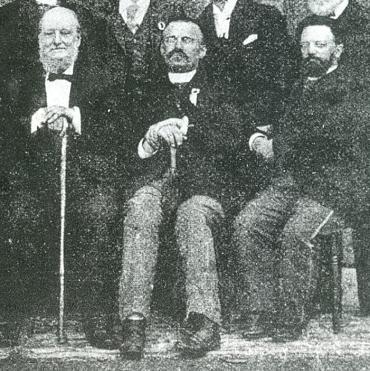
H.E. Bird, G. Marco, M. Chigorin
5833. Illegal move
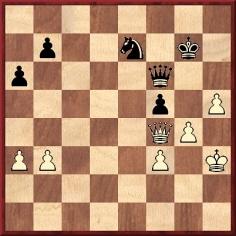
This position occurred after 54 g4 in the game between Vladimir Simagin and Jaroslav Šajtar in the Moscow v Prague match on 10 March 1946. Play is recorded as continuing 54...fxg4+ 55 Qxg4+, and a draw was agreed at move 63.
The game was given on pages 24-25 of Moscow v. Prague 1946 (Sutton Coldfield, 1946), and Oliver Beck (Seattle, WA, USA) informs us that in his copy a previous owner, Paul Hugo Little, noted that according to the 4/1946 issue of Shakhmaty v SSSR Simagin originally played 55 Qxf6+, and after 55...Kxf6 56 fxg4 the game continued for ten moves before it was realized that his 55th move was illegal. The game was then replayed with 55 Qxg4+.
Mr Beck asks for more information about the episode,
and readers’ assistance will be appreciated.
We note that on pages 24-25 of Chess Lists (Jefferson, 2002) A. Soltis wrote regarding the position after 55 Qxf6+:
‘The spectators, who followed the moves on a demonstration board, burst into laughter. But Black instantly responded 55...Kxf6 and after 56 fxg4 the game went on as if nothing had happened.’
No source is given. There is only Soltis’ say-so, which amounts to very little more than not very much.
5834. Alekhine photograph
Michael Clapham (Ipswich, England) forwards a photograph of Alekhine playing a game of living chess, against Bogoljubow, at the Münsterplatz, Villingen, Germany in April 1934:
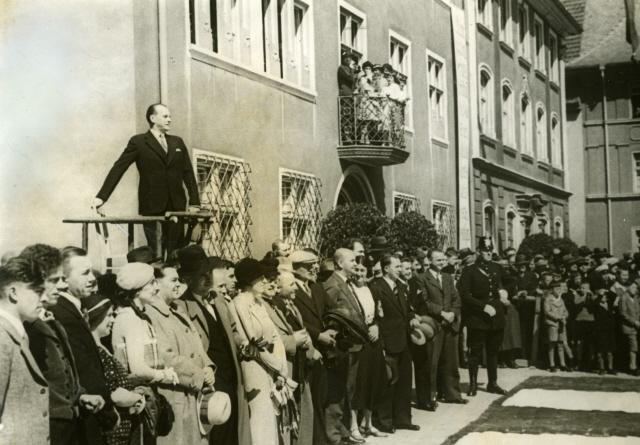
Below is the information provided on the reverse of the picture:
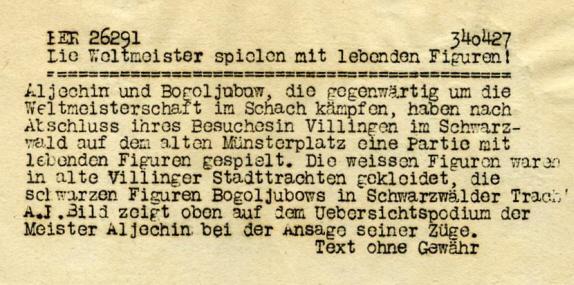
5835. Alekhine simultaneous game
Also from Mr Clapham comes this game, from a 25-board display:
Alexander Alekhine v KeltischMunich, 18 September 1941
Alekhine’s Defence
1 e4 Nf6 2 e5 Nd5 3 c4 Nb6 4 d4 d6 5 Nf3 Bg4 6 Be2 dxe5 7 Nxe5 Bxe2 8 Qxe2 N8d7 9 c5 Nd5

10 c6 Nxe5 11 cxb7 Rb8 12 dxe5 e6 13 Qb5+ Qd7 14 Qxd7+ Kxd7 15 Nc3 Bb4 16 Bd2 Bxc3 17 Bxc3 Nxc3 18 bxc3 Rxb7 19 O-O Rd8 20 f4 Ke7 21 Rf2 Rdb8 22 Rd2 Rb1+ 23 Rxb1 Rxb1+ 24 Kf2 Rc1 25 Ke3 Rxc3+ 26 Kd4 Rc1 27 Ke3 h5 28 g3 a5 29 Rd4 Rc5 30 Ke4 g6 31 a3 c6 32 Rd3 Rd5 33 Rb3 Kd8 34 Rb7 Rd7 35 Rxd7+ Kxd7 36 Kd4 Kc7 37 Kc5 Kb7 38 h3 Kc7 39 g4 hxg4 40 hxg4 Kb7
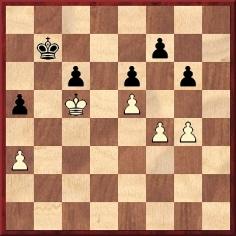
41 g5 Kc7 42 a4 Kb7 43 Kd6 Kb6 44 Ke7 c5 45 Kxf7 c4 46 f5 c3 47 fxg6 c2 48 g7 c1Q 49 g8Q Qf4+ 50 Ke7 Qb4+ 51 Kf6 Qf4+ 52 Ke7 Qb4+ 53 Kf6 Qf4+ 54 Ke7 Drawn.
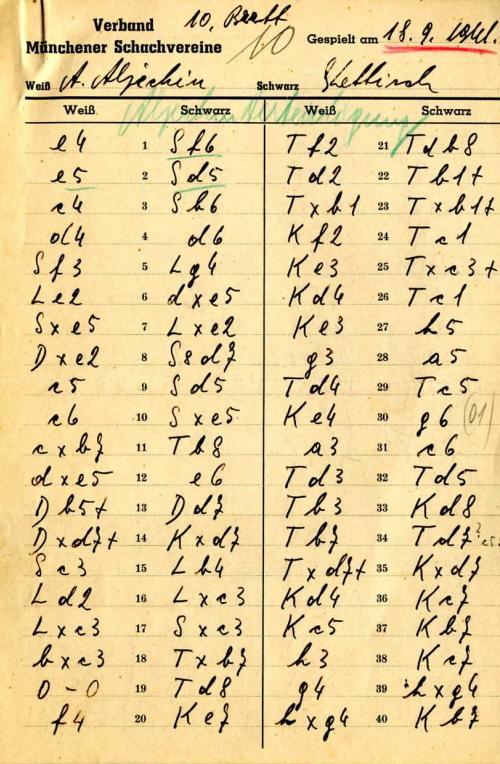
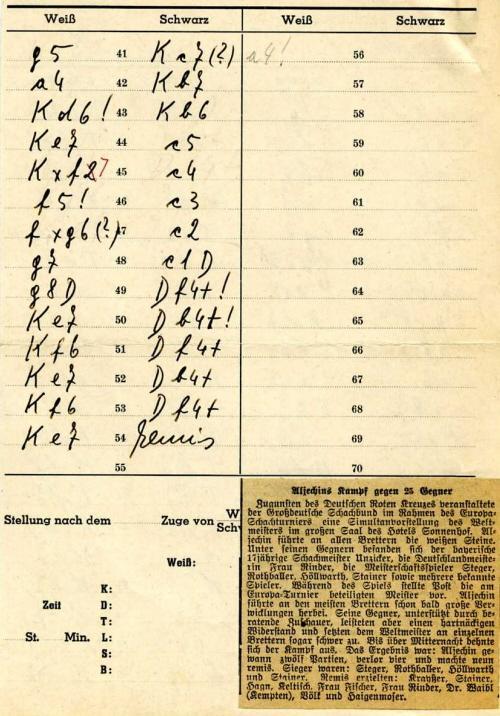
In the newspaper report Unzicker is mentioned as one of Alekhine’s opponents. A photograph featuring both of them was given in C.N. 4373.
5836. Hastings, 1895
We are grateful to Antonio Rosino (Venice, Italy) for supplying the rare Hastings, 1895 photograph referred to in C.N.s 4663 and 5832:

For a large version, click here. There are
several misspellings; for example, the President of the
Committee of Management was J. Watney.
Mr Rosino informs us that he was given the photograph by the late Achille Martini, who was the founder and President of the Circolo Scacchistico Beniamino Vergani in Montebelluna.
5837. Capablanca v Thomas (C.N. 5310)
C.N. 5310 discussed the famous conclusion to the game Capablanca v Thomas, Hastings, 1919:
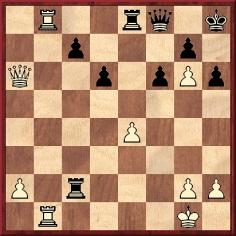
Instead of winning a rook with 29 Rxe8 Qxe8 30 Qa4, Capablanca played 29 Qa8. Thomas then resigned, but could have drawn with 29...Rxa2.
We add now that Fred Reinfeld gave the position on pages 100-102 of Why You Lose at Chess (New York, 1956). After 29 Qa8 he wrote:
‘Convinced – in fact, overwhelmed – Thomas resigned without looking any further.
And yet he had a won game. [Emphasis added by us.]
How? Simply by playing: 29...Rxa2!! If now 30 Rxe8 Rxa8 31 Rxf8+ Rxf8, and Black is in no danger, with a pawn to the good. Or 30 Qxa2 Rxb8, with the same result.’ [Reinfeld’s notes have been converted to the algebraic notation, with the moves renumbered.]
The reference to ‘a won game’ for Black may be regarded as an exaggeration, given that the rook ending appears to be a clear draw if White brings up his king immediately.
Concerning the claim that Blackburne was the onlooker who discovered that Thomas could have saved the game, C.N. 5310 mentioned that Bruce Hayden had named E.G. Sergeant as his authority for that information. On page 20 of the January 1988 BCM, however, Hayden indicated that his source was Brian Harley.
5838. Sound recordings
In C.N. 938 (see pages 122-123 of Chess Explorations) Dale Brandreth asked about the existence of sound recordings featuring such old masters as Lasker, Capablanca and Alekhine, and the question is now raised again by Steve Wrinn (Syracuse, NY, USA). Noting that in 2003 a brief interview with Alekhine (recorded by the BBC in 1938) was presented at the Chess Café, he asks if any similar material can be found.
We have often wondered whether recordings have survived of Capablanca’s radio lectures in Spanish in the early 1940s.
5839. Daniel Harrwitz
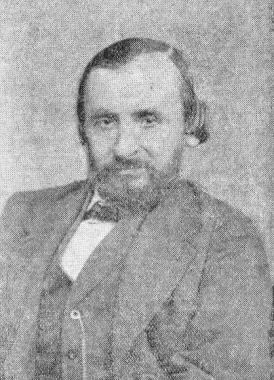
This picture of Daniel Harrwitz is taken from page 269 of volume two of Aus Vergangenen Zeiten by Ludwig Bachmann (Berlin, 1920-22). Does any reader know of a better copy?
Below are two sample chess columns by Harrwitz, from pages 60 and 179 of the first quarterly volume of The Family Friend. The columns are not dated, but the tome’s Preface ends ‘London, 24 September 1852’.
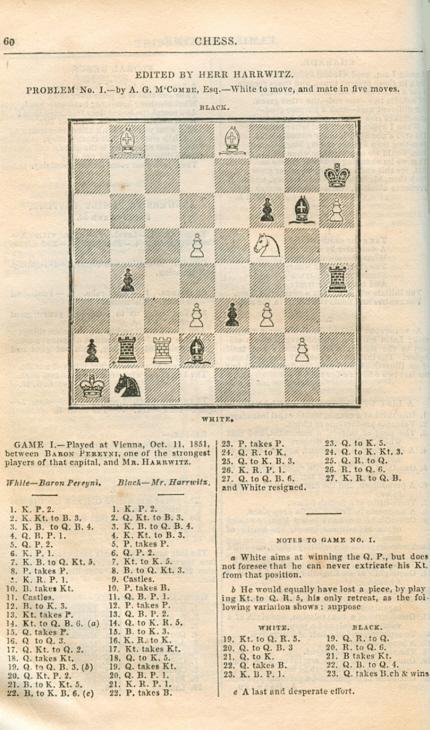

5840. Chess and mathematics
Michael McDowell (Westcliff-on-sea, England) quotes from page 15 of A Mathematician’s Apology by G.H. Hardy (Cambridge, 1940):
‘The fact is that there are few more “popular” subjects than mathematics. Most people have some appreciation of mathematics, just as most people can enjoy a pleasant tune; and there are probably more people really interested in mathematics than in music. Appearances suggest the contrary, but there are easy explanations. Music can be used to stimulate mass emotion, while mathematics cannot; and musical incapacity is recognized (no doubt rightly) as mildly discreditable, whereas most people are so frightened of the name of mathematics that they are ready, quite unaffectedly, to exaggerate their own mathematical stupidity.
A very little reflection is enough to expose the absurdity of the “literary superstition”. There are masses of chessplayers in every civilized country – in Russia, almost the whole educated population; and every chessplayer can recognize and appreciate a “beautiful” game or problem. Yet a chess problem is simply an exercise in pure mathematics (a game not entirely, since psychology also plays a part), and everyone who calls a problem “beautiful” is applauding mathematical beauty, even if it is a beauty of a comparatively lowly kind. Chess problems are the hymn-tunes of mathematics.
We may learn the same lesson, at a lower level but for a wider public, from bridge, or descending farther, from the puzzle columns of the popular newspapers. Nearly all their immense popularity is a tribute to the drawing power of rudimentary mathematics, and the better makers of puzzles, such as Dudeney or “Caliban”, use very little else. They know their business: what the public wants is a little intellectual “kick”, and nothing else has quite the kick of mathematics.’
See also pages 222-223 of King, Queen and Knight by Norman Knight and Will Guy (London, 1975).
The best-known remark in the above passage is ‘Chess problems are the hymn-tunes of mathematics’. The context suggests that the comparison was hardly intended as a compliment.
5841. Hastings, 1895 (C.N. 5836)
Peter Wood (Hastings, England) notes that the group photograph was taken in front of the entrance to Battle Abbey, which was built on the site of the Battle of Hastings of 1066.
5842. The Jew of Chamant
Frederick S. Rhine (Park Ridge, IL, USA) writes:
‘I have found that G.H.D. Gossip apparently published a book, not about chess for once, entitled The Jew of Chamant. Page 86 of The Library Journal of February 1899, issued by the American Library Association, shows that “Trepoff, Ivan”, the pseudonym of “G. Hatfield Dingley Gossip”, brought out “The Jew of Chamant; or, the modern Monte Cristo”, published by Hausauer of Buffalo, NY in 1898. Another source indicates that the book was published in 1899 by F.T. Neely (London and New York) as “The Jew of Chamant: a romance of crime”.’
We note too the entry in the Library of Congress Online Catalog. Can any reader find a copy of the book?
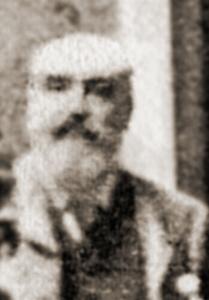
G.H.D. Gossip (detail from the New York, 1893 group photograph)
5843. The anecdotalist’s plural
From an article ‘Unconventional Surrender’ by Hans Kmoch and Fred Reinfeld on page 55 of the Chess Review, February 1950:
‘Alekhine hit on still another way of resigning during the Vienna tournament of 1922. ... When he saw that Grünfeld had sealed 54...Q-B6 (the strongest move), Alekhine resigned – by taking his king and throwing it across the room.’
From page 4 of Why You Lose at Chess by Fred Reinfeld (New York, 1956):
‘Hans Kmoch and I once surveyed [methods of resigning] in an article called “Unconventional Surrender”. We recalled that Alekhine, who was unequaled as a desperate fighter in disheartening situations, occasionally [our emphasis] resigned by picking up his king and hurling it across the room.’
Notwithstanding the word ‘occasionally’, the Kmoch/Reinfeld article had not suggested that the conclusion of the Alekhine v Grünfeld game was other than an isolated incident.
As noted in Chess with Violence, Kmoch was a participant in Vienna, 1922, but does any other source corroborate the claim about Alekhine which Kmoch made nearly three decades later?
5844. Morphy v Steinitz
Michael Clapham (Ipswich, England) sends an extract from the chess column by J.H. Sweet in the American Chronicle, 12 March 1868:

Our correspondent adds:
‘I have every column from its inception on 7 November 1867 up to the last, dated 30 July 1868, but I can find no further mention of these games, or a retraction.’
David Lawson discussed the matter on pages 288-289 of his 1976 biography of Morphy. After quoting Wilkes’ Spirit of the Times from early 1868 (‘Rumor says that he [Morphy] has played four games with Mr Steinitz, losing one and drawing three’), Lawson wrote:
‘Unfortunately for the chess world, they had not met, nor did they until 1883 during Steinitz’s visit to New Orleans. About this time, 1863 [sic], Steinitz had had several games with a Mr Murphy of London, and evidently someone, finding Steinitz’s opponent rather vaguely described, thought it was Morphy. This mistake was made even though Steinitz was conceding odds of pawn and move to his opponent, which should have canceled the possibility that the opponent was Morphy. Some of these games were published in 1863 in the Chess Player’s Magazine.’
5845. Quiz question
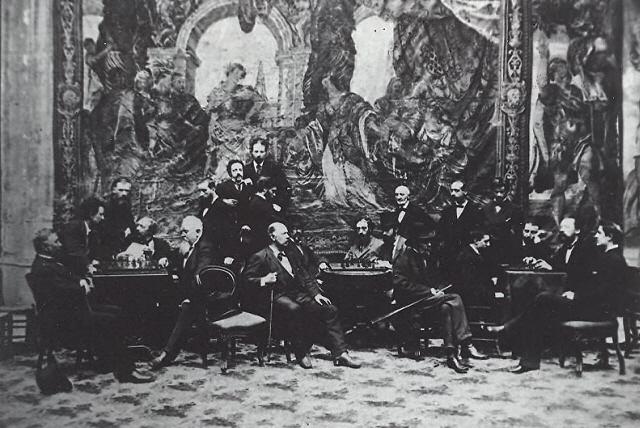
What is the connection between the city where this tournament was held and a pupil of Capablanca’s?
5846. A first
challenger to Alekhine in 1927
Dominique Thimognier (St Cyr sur Loire, France) sends this bizarre cutting from Le Figaro of 3 December 1927:
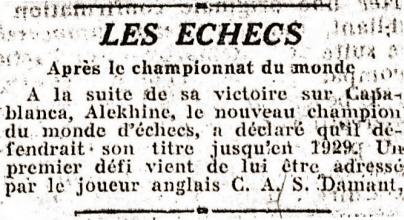
For reasons unexplained, the French newspaper reported that the new world champion, Alekhine, had just been sent a first challenge for his title, by the English player C.A.S. Damant.
5847.
Gromer (C.N.s 5135 & 5487)

Aristide Gromer (El
Ajedrez Español, October-November 1935, page
472)
Our correspondent informs us that he has produced a page about Aristide Gromer on his Héritage des échecs français website.
5848. Quiz question (C.N. 5845)
Giving the correct answer to the question in C.N. 5845 (the tournament took place in Rome in 1875 – Roma being an anagram of Mora), Mr Thimognier provides this picture from page 364 of L’Illustrazione Universale of 11 July 1875:
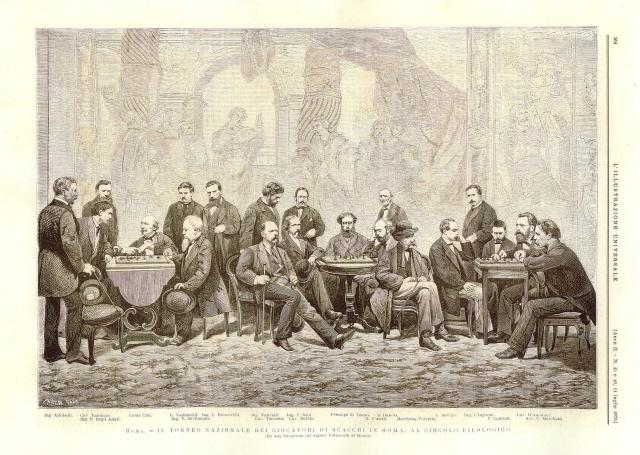
For a large version, click here.
The photograph in C.N. 5845 came from Antonio Rosino (Venice, Italy). It was published in a book co-authored by him with Adriano Chicco, Storia degli scacchi in Italia (Venice, 1990).

5849. Famous Flohr victory
One of Salo Flohr’s most famous games – see, for instance, pages 40-44 of The Most Instructive Games of Chess Ever Played by Irving Chernev (New York, 1965) – is his victory over Rafael Domènech at Rosas, 1935. Although White is customarily said to have given up in the pawn ending after 30 Kxd2 Kd6, the game continued 31 c5+ Kxc5 and ‘White resigned a few moves later’ according to Flohr in his notes on page 337 of El Ajedrez Español, July 1935.
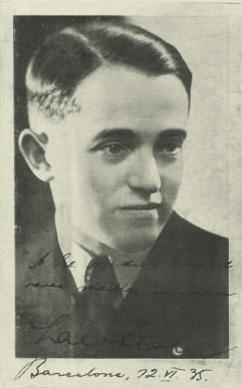
Salo Flohr (El
Ajedrez Español, July 1935, opposite page 336)
Biographical details regarding Domènech are sought. This small photograph of him was published on page 506 of the December 1935 issue of the Spanish magazine:
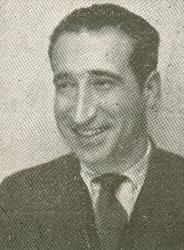
We use the spelling Domènech, with an accent, since his name was written that way in a magazine to which he regularly contributed, Els Escacs a Catalunya. Here, for example, is the mast-head of the January-February 1936 issue:

5850. ‘Extraordinary’
Olimpiu G. Urcan (Singapore) sends this cutting from page 1 of the Seattle Gazette, 2 February 1864:
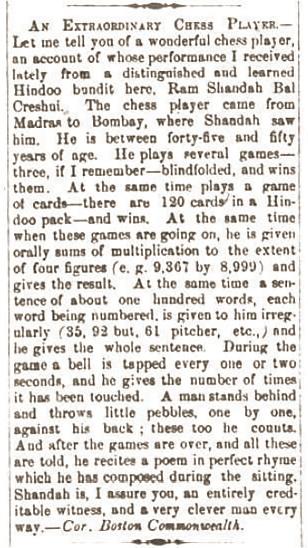
5851. Game conclusion
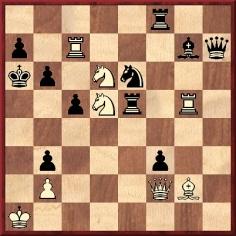
Black to move
We shall be reverting to this position shortly, but in the meantime should like to know whether any reader recognizes it.
5852. Tempo
Concerning the Earliest Occurrences of Chess Terms, Volfango Rizzi (Chester, England) suggests an entry for ‘tempo’.
The following appeared as a note to White’s 8th move in ‘a fine contest played at Kling’s Chess Rooms, between two strong players’ on page 36 of The New Chess Player, 28 August 1852:
‘Black, by sacrificing Pawn, gains a tempo, bringing all his pieces into action.’
The game’s other two notes also mixed up White and Black, and the score itself was garbled. A correct version is given below:
Players and occasion?(Odds of pawn and two moves. Remove Black’s f-pawn.)
1 e4 … 2 d4 Nc6 3 Be3 e5 4 Bc4 Nf6 5 d5 Ne7 6 Nc3 Ng6 7 g3 Bb4
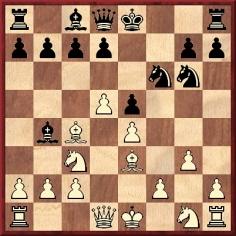
8 Ne2 Nxe4 9 O-O Nxc3 10 bxc3 Ba5 11 f4 e4 12 f5 Ne5 13 Bb3 d6 14 Nd4 Bxc3 15 Qh5+ Nf7 16 Ne6 Qe7 17 Rad1 Kd7
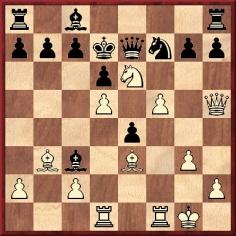
18 f6 Bxf6 19 Ba4+ c6 20 dxc6+ bxc6 21 Bxc6+ Kxc6 22 Qd5+ Kd7 23 Qb5+ Kxe6 24 Qf5 mate.
The word ‘tempo’ in its chess sense does not currently appear in the Oxford English Dictionary. It is not the easiest term to explain concisely, and we wonder whether any reader can propose a better definition than B.H. Wood’s on page 115 of Easy Guide to Chess (Sutton Coldfield, 1942):
‘A move, or turn to play, considered as a unit of time. Thus “to lose a tempo” is to make a useless move.’
5853. Seesaw
Regarding the seesaw, or windmill, manoeuvre, the earliest instance of the word ‘seesaw’ found so far appeared on page 251 of the American Chess Magazine, September 1897:
‘A pretty so-called seesaw of checks finishes the game ...’
John Simpson (Oxford, England), the Chief Editor of the Oxford English Dictionary, notes an earlier, different, use of the term on page 263 of the Chess Player’s Chronicle, 1849:
‘This see-saw is pretty enough. White evidently must not accept the proffered donum.’
The proffered donum was the black rook, the note being appended to Black’s 38th move. The full game, from pages 262-263 of the Chronicle, was:
Henry Edward Bird – Elijah WilliamsOccasion?
French Defence
1 e4 e6 2 d4 d5 3 exd5 exd5 4 Nf3 Nf6 5 Bd3 Bd6 6 O-O O-O 7 c3 Ne4 8 Nbd2 f5 9 c4 c6 10 cxd5 cxd5 11 Qb3 Kh8 12 Qc2 Nc6 13 a3 h6 14 b4 a6 15 Nb3 Qf6 16 Bb2 g5 17 Nfd2 g4 18 f4 gxf3 19 Rxf3 Qh4 20 Rh3 Qg5 21 Re1 Rg8 22 Nf3 Qg7 23 Ne5 Bxe5 24 dxe5 Be6 25 Bc1 f4 26 Rh4 Raf8 27 Bxf4 Ng5 28 Kh1 Ne7 29 Nd4 Bf7 30 e6 Bg6 31 Bxg6 Qxg6 32 Qxg6 Rxg6 33 Bxg5 Rxg5 34 Rxh6+ Kg7 35 Rh3 Re5 36 Rg3+ Ng6
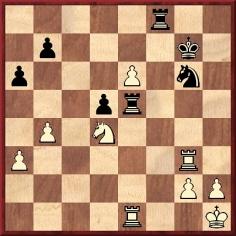
37 Rc1 Rc8 38 Rf1 Rf8 39 Kg1 Rxf1+ 40 Kxf1 Re4 41 e7 Kf7 42 Nf5 Rf4+ 43 Rf3 b6 44 Kf2 a5 45 bxa5 bxa5 46 Kg3 Rxf3+ 47 Kxf3 Ne5+ 48 Ke3 Nc4+ 49 Kd4 Nxa3 50 Kxd5 Nb5 51 Nd6+ Nxd6 52 Kxd6 Ke8 53 Kc5 and White won.

Henry Edward Bird (Scientific American Supplement, 20 October 1877, page 1502)
5854. Further lexicological research
An increasing number of chess books and periodicals can be consulted at the Google Books website, which provides a very practical way of searching for early instances of chess vocabulary. Information from readers on their findings will be most welcome.
5855. Miserable
‘Lasker and Schlechter signed a secret protocol’ is the heading on page 46 of The Genius and the Misery of Chess by Zhivko Kaikamjozov (Newton Highlands, 2008), and the following page affirms:
‘The match rules [i.e. for the 1910 encounter] weren’t published anywhere and the above-mentioned clauses were secret, known only by the players and two confidants. The protocol from the match was revealed much later, after the death of the last of the four men who knew the secret.’
Naturally the ‘two confidants’ are left unidentified,
as is the person who revealed the ‘protocol’, as well as
everything else that the reader would expect to be told.
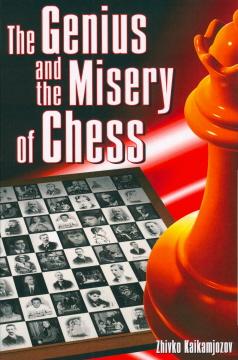
Another heading, on page 26, reads: ‘Mister Morphy, you have won the match, because you are stronger than me.’ These words, according to Mr Kaikamjozov, ‘Staunton pronounced in broken French’. Overleaf it is averred that, later on, Morphy ‘became paranoid, despised everyone’ and that ‘a loaded gun was kept on his bedside table at all times’.
That Morphy chapter (pages 23-29) shows the author at his most fabulistic, and we have seldom seen anything quite so bad.
5856. Fischer quote (C.N.s 5824 & 5830)
Regarding the observation ‘I don’t believe in psychology. I believe in good moves’, Stefan Müllenbruck (Trier, Germany) draws attention to a brief YouTube video clip of Fischer.
5857. Maxim
‘It is always too early for P-KB4.’ This is vaguely described as a ‘maxim by a well-known foreign Master’ on page 18 of One Hundred Chess Maxims by C.D. Locock (Leeds, 1930). In the second edition, published later in the 1930s, see page 19. What more is known about the saying?
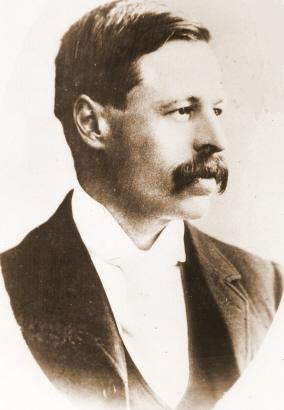
Charles Dealtry Locock
Locock published his reminiscences on pages 7-12 of the January 1933 BCM, and the final passage is reproduced here:
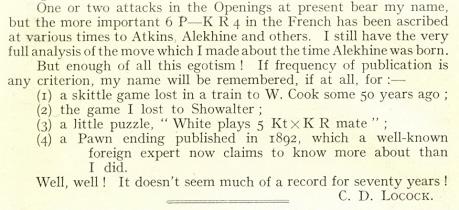
5858. An
unprecedented lunge
From W. Cook to W. Cooke. Below is the only instance we recall of a tournament game in which White gave mate at move two. Black offered the odds of his f-pawn, and the score appeared on page 239 of the July 1916 BCM:
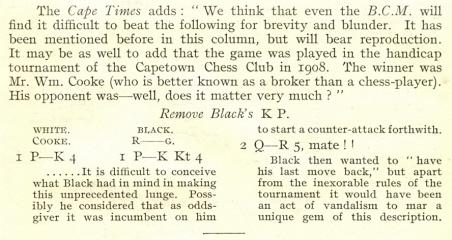
5859. Bronstein’s grave
Yakov Zusmanovich (Pleasanton, CA, USA) has sent us, courtesy of Sergei Voronkov, a photograph of David Bronstein’s grave, located in a cemetery (Чижовскоe) in Minsk, Belarus.
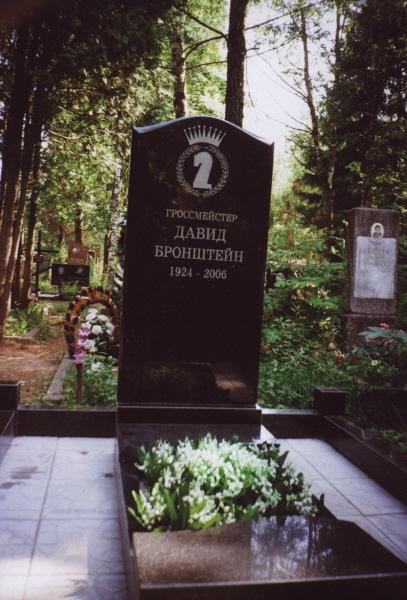
The photograph was taken by Bronstein’s widow, Tatiana Boleslavsky, who is the daughter of Isaac Boleslavsky.
5860. A deciphering challenge
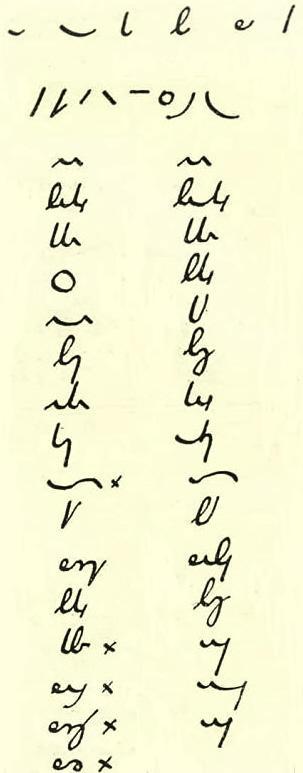
5861. Disputes
Below is a further article by G.H. Diggle, the Badmaster, from page 90 of Chess Characters (Geneva, 1984). It was originally published in the January 1983 issue of Newsflash.
‘The bellicose BM, who keeps a collection of chess disputes in letters, articles and pamphlets going back over 150 years, has duly added to his catalogue the correspondence in December Newsflash in which two most eminent lady players cross swords in fair fight and with due regard to the rules of honourable controversy. But alas! compared with the fights of Victorian days, “what a falling off was there!”
In 1848 Staunton, whose match career since 1843 had been an unbroken success both on level terms and at odds, finally lost a match at “pawn and two” to the least likely player imaginable – namely, Edward Löwe, a perfunctory old Divan player considered to be a very soft touch, as he seldom attacked or made a combination but “just pottered along without having the road up at every step”. The defeated Staunton rose to the occasion magnificently – “You see, sir”, he told a friend, “the odds were not large enough – I could not play my best. I ought to have given him a Knight!” But a fiery anti-Stauntonian, Thomas Beeby of Dyers Hall College, wrote triumphantly to the Morning Post, “The result has proved that Mr Staunton, though never in better play, and having won at the same odds against Mr Harrwitz, Captain Kennedy and other celebrated players, has on the present occasion been over-matched”. At this the high-spirited Captain Kennedy, annoyed at the inference that Löwe was stronger than himself, sprang to the defence of Staunton’s reputation (and his own): “I believe it to be a pleasant delusion (mentis gratissimus error) on the part of Mr Löwe and his friends that Mr Staunton is unable to yield him the odds of pawn and two. It was commonly remarked amongst those who witnessed the match that Mr S. played loosely and considerably below his ordinary pitch, being somewhat rusty for lack of practice. Had Mr S. fought the match in the same trenchant fashion as he did in his former engagements with Mr Harrwitz and myself, I make bold to asseverate that Mr Löwe would have been routed horse, foot, and artillery ... ”
Beeby replied with an enormous letter which wound up by “offering Mr Löwe an engagement at his (Beeby’s) own expense to play Captain Kennedy a match of 25 games the games to be published without note or comment, but on the express understanding that whatever the result, we hear nothing of indigestion, indisposition, headache, want of preparation, rustiness, or any other excuse, however ingenious, as palliative of defeat!” Captain Kennedy affected to regard the last paragraph as an imputation on his temperance and refused to correspond further with Beeby, but agreed to play the match and handed over all negotiations to Mr Turner, the Secretary of the Brighton Chess Club, a high-handed gentleman who (after some heated exchanges with Beeby) followed the Captain by “breaking off all relations”: “I am more than sorry – I am ashamed – that I ever addressed you at all. I desire that you will not write to me again on this or any other subject, as it is not my intention to hold any further communication with you.” Beeby then let himself go in a searing pamphlet: “To reason with such a man as Turner, is like stabbing at water, like cudgeling a woolsack ... I nevertheless endeavoured to dwarf myself to the measure of his capacity by writing in such a manner that no-one not worthy of being an inmate in a lunatic asylum could escape my meaning – the attempt, however, failed, Turner was impervious to reason.” Amazing to relate, the Match did later come off, Löwe winning 7-6-1.’
5862. Kolisch problems
From Fabrizio Zavatarelli (Milan, Italy):
‘In C.N. 5330 Michael McDowell asked whether a problem published in La Régence is the only one composed by Kolisch. I have found two others ascribed to him, in Shakhmatnyy listok, 1862. The first, on page 139, is a slight variation on the one in the French magazine; the white king is on a6, not a7, and there is a black rook, not pawn, on f4.
The second problem is on page 212:
The task is: “White moves and gives mate in four moves with the pawn.”’
Mr McDowell points out to us that this is simply a
version of a composition published on page 64 of Praktische
Sammlung bester und höchst interessanter
Schachspiel-Probleme by Aaron Alexandre (Leipzig,
1846):
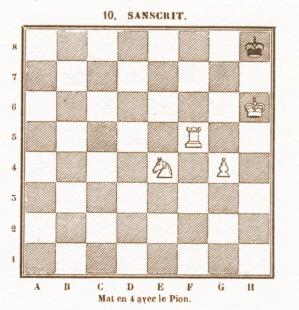
5863. Kolisch games
Mr Zavatarelli also writes:
‘I am collecting the games of Kolisch and now have about 260, with original sources. The only game which I have solely from a web database is Turgenev v Kolisch (occasion?): 1 e4 e5 2 Nf3 Nc6 3 Bc4 Nf6 4 Ng5 d5 5 exd5 Na5 6 d3 h6 7 Nf3 e4 8 Qe2 Nxc4 9 dxc4 Bc5 10 Nfd2 O-O 11 h3 e3 12 fxe3 Bxe3 13 Kd1 Re8 14 Qf3 Bxd2 15 Nxd2 c6 16 b3 cxd5 17 Bb2 Ne4 18 c5 Qg5 19 Bc1 Qxg2 20 Rf1 Nc3+ 21 White resigns.
Is there a reliable source for this game?’
5864. A pair of Capablanca photographs
Olimpiu G. Urcan (Singapore) notes that additions continue to be made to the Library of Congress photograph collection and he draws particular attention to a pair of pictures of Capablanca dated 1915.
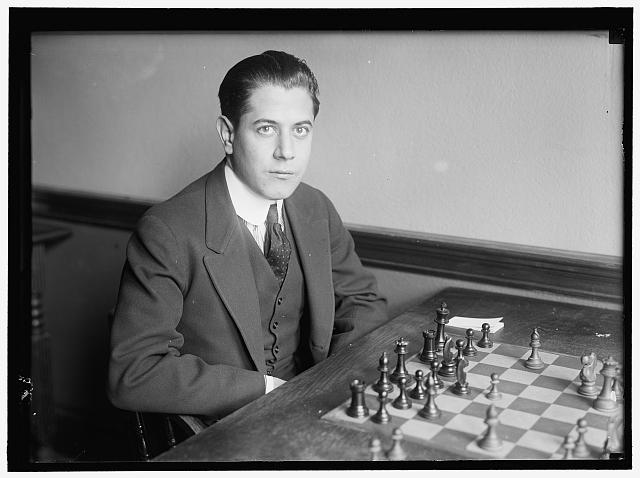
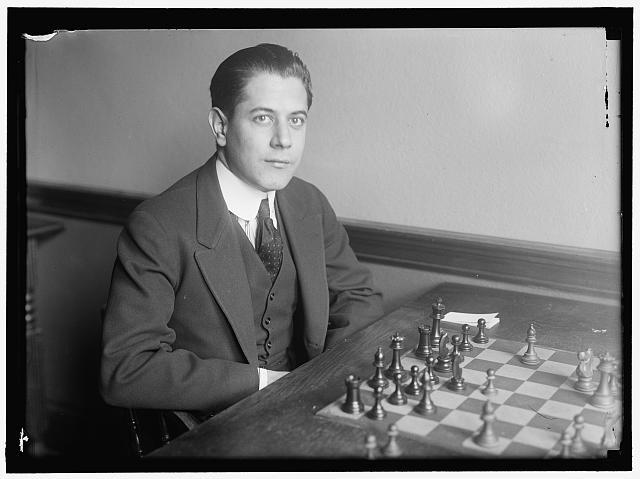
The following shot appeared on page 278 of The
Golden Dozen by Irving Chernev (Oxford, 1976):
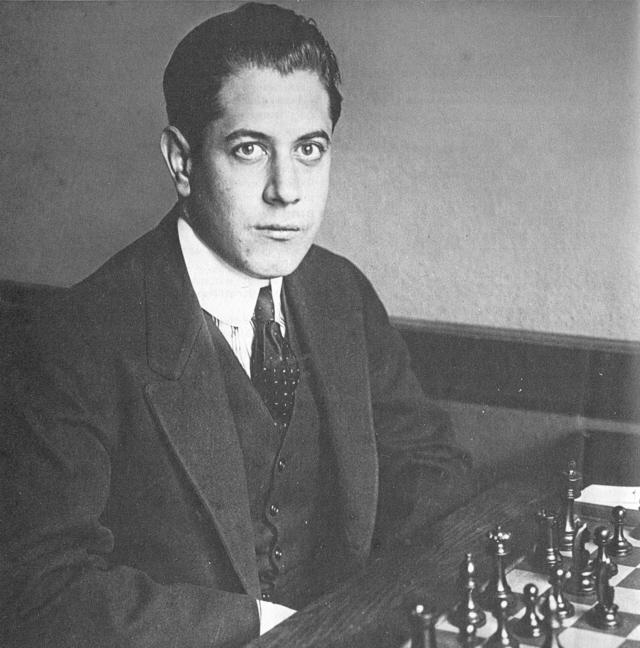
The Library’s conditions for use of its pictures should be noted. A search for chess photographs at the website also yields a good shot of Tartakower and Edward Lasker.
5865. Queen’s knight’s pawn (C.N. 5827)
From page 13 of One Hundred Chess Maxims by C.D. Locock (Leeds, 1930):
‘The queen should usually be kept in the background till a promising attack is established. Avoid using her for hunting distant pawns, such as the QKtP. It takes two moves for the queen to take it and get home again – if she can.’
Frederick S. Rhine (Park Ridge, IL, USA) quotes from page 220 of The Game of Chess by Siegbert Tarrasch (London, 1935):
‘It is very dangerous to make a raid with the queen early on in the game. In particular, the capture of the queen’s knight’s pawn with the queen often brings its own revenge.’
This text appeared on page 312 of the original German edition, Das Schachspiel (Berlin, 1931):
‘Sehr bedenklich ist es, mit ihr im Anfang des Spieles auf Beute auszugehen. Besonders die Eroberung des b-Bauern durch die Dame rächt sich häufig.’
5866. The Jew of Chamant (C.N. 5842)
Reverting to the published statement that G.H.D. Gossip wrote a work of fiction, The Jew of Chamant, under the name Ivan Trepoff, Mr Rhine notes that according to page 1037 of American Fiction, 1901-1925: A Bibliography by Geoffrey D. Smith (Cambridge, 1997) ‘Ivan Trepoff’ was a pseudonym of Herman Arthur Haubold (1867-1931).
We have acquired a copy of the novel Spiritmist by Ivan Trepoff, published by Donald W. Newton, New York in 1909. The second page of the Preface was dated two years after Gossip died:
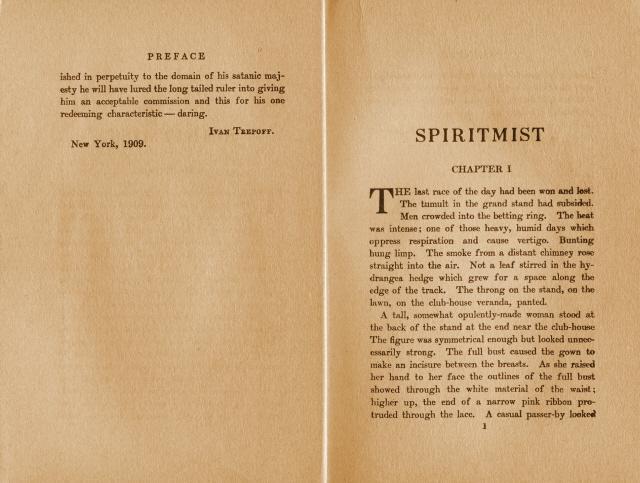
Did two writers use the same pseudonym, or was The Jew of Chamant written by Haubold, and not Gossip?
5867. A decoding task
Eduardo Bauzá Mercére (New York, NY, USA) draws attention to this item on page 77 of CHESS, January 1946:

CHESS subsequently reported that three readers (including Gordon Crown) had achieved the ‘extraordinary feat’ of reconstructing the game as far as move 26. Their solution, together with a proposal from Mr Bauzá Mercére for the complete game, will be given here in due course.
5868. London, 1899
As mentioned in our feature article on London, 1899, a reader suggested a caption for this rare picture:
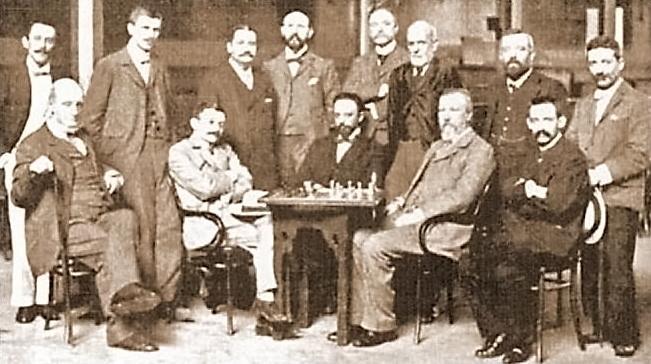
Photograph of some of the participants, contributed by Pierre Bourget (Quebec, Canada) in C.N. 5328. He subsequently proposed the following key: Standing (from left to right: D. Janowsky, G. Maróczy, F.J. Lee, L. Hoffer, J.W. Showalter, S. Tinsley, R. Teichmann and W. Cohn. Seated: H.E. Bird, E. Lasker, M. Chigorin, J.H. Blackburne and C. Schlechter. Absent: J. Mason, H.N. Pillsbury and W. Steinitz.
Joost van Winsen (Silvolde, the Netherlands) suggests that the player identified as Showalter was J. Walter Russell, one of the secretaries of the organizing committee, and that the figure named as Teichmann was H.W. Trenchard.
For purposes of comparison, Mr van Winsen refers to a group photograph published opposite page 1 of the January 1898 BCM:
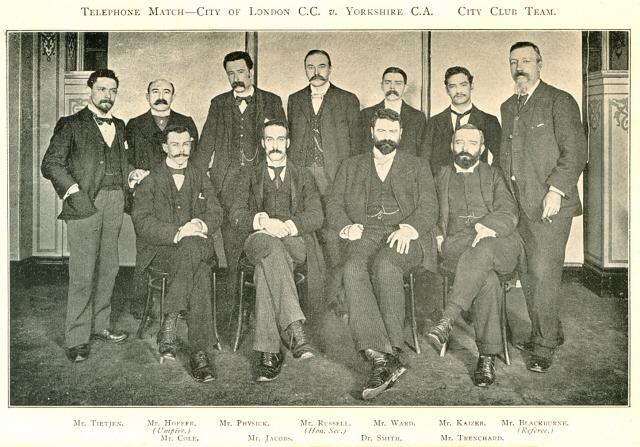
5869. First tournaments
Jud McCranie (Brunswick, GA, USA) notes the start of the ‘Tournament’ entry on page 426 of the second edition of the Oxford Companion to Chess by D. Hooper and K. Whyld (Oxford, 1992):
‘The word “tournament” owes its modern meaning to chess. Originally martial sports for knights, tournaments died out, after more than 600 years, during the Renaissance. In 1839 the Earl of Eglintoun re-created the tournament, with a lavish feast, as an entertainment. The event stirred the imagination of the public in general, and Walker in particular. In Bell’s Life he began to use jousting terms in his accounts of chess events, and described a gathering of Yorkshire players in Leeds in 1841 as a “tournament”. The term caught on and was firmly established by the time of the first international event of this kind, London 1851, won by Anderssen.’
Our correspondent asks about tournaments which pre-dated London, 1851 and draws particular attention to the above reference to a gathering in Leeds.
The first two events recorded in volume one of Chess Tournaments A Checklist by Jeremy Gaige (Philadelphia, 1985) were knock-out contests in London, 1849 (won by H.T. Buckle) and Amsterdam, 1851 (won by M. van ’t Kruijs). Then came London, 1851.
What is the best source for information about the Dutch tournament? As regards the Leeds event in 1841, page 53 of that year’s Chess Player’s Chronicle described it as ‘the Chess Witenagemot’:
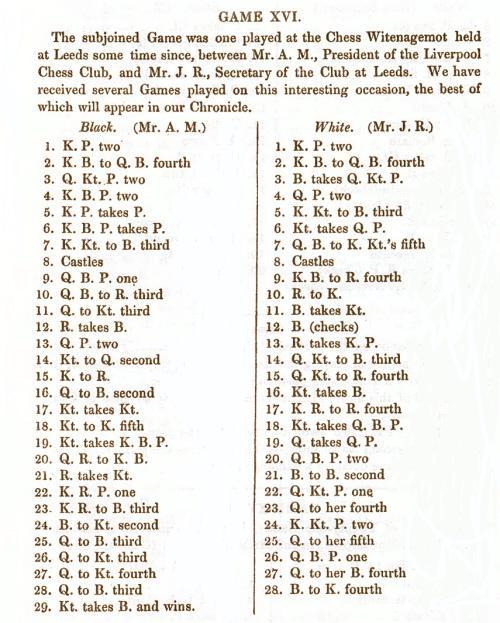
1 e4 e5 2 Bc4 Bc5 3 b4 Bxb4 4 f4 (In annotations to the 24th game between McDonnell and Labourdonnais on page 9 of the second volume of the Chess Player’s Chronicle it was commented after 4 f4 that ‘this opening, known as the “double Gambit”, is the invention of Mr M‘Donnell’.) 4...d5 5 exd5 Nf6 6 fxe5 Nxd5 7 Nf3 Bg4 8 O-O O-O 9 c3 Ba5 10 Ba3 Re8 11 Qb3 Bxf3 12 Rxf3 Bb6+ 13 d4 Rxe5 14 Nd2 Nc6 15 Kh1 Na5 16 Qc2 Nxc4 17 Nxc4 Rh5 18 Ne5

18...Nxc3 19 Nxf7 Qxd4 20 Raf1 c5 21 Rxc3 Bc7 22 h3 b6
23 Rcf3 Qd5 24 Bb2 g5 25 Qc3 Qd4 26 Qb3 c4 27 Qb4 Qc5 28
Qc3 Be5 29 Nxe5 and wins.
Information is sought on early occurrences of the term ‘tournament’ in chess writing. It appeared twice, though not in the modern sense, in an article by George Walker entitled ‘Chess, without the chess-board’ published on pages 302-318 of Fraser’s Magazine, March 1840 and reproduced on pages 106-147 of his book Chess & Chess-Players (London, 1850).
| First column | << previous | Archives [52] | next >> | Current column |
Copyright: Edward Winter. All rights reserved.
